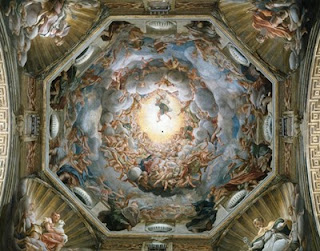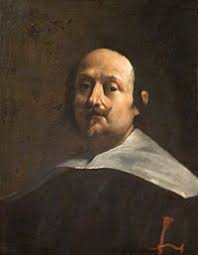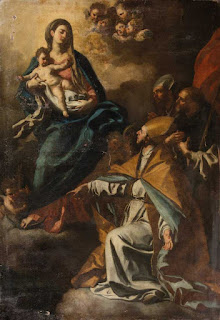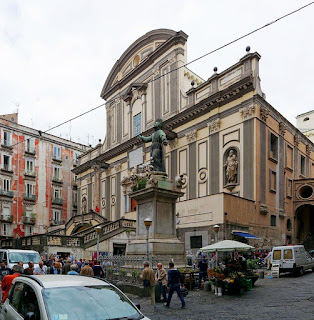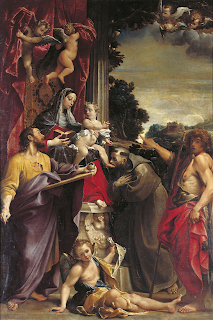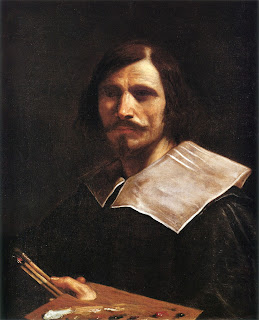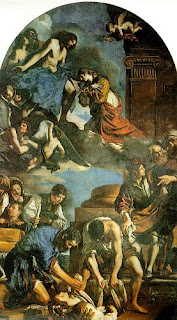Historic facility hit in 1944 air raid
 |
| The Archiginnasio anatomical theatre is surrounded by statues of eminent physicians carved in wood |
The northern Italian city was a frequent target during the final two years of the conflict because of its importance as a transport hub and communications centre. The wing of the palazzo housing the anatomical theatre, built between 1636 and 1638, took a direct hit on the night of January 29.
Although it is unlikely that the university - the oldest in the world - was a specific target, bombing was much less precise 75 years ago and collateral damage was common and often widespread.
As well as its importance in the history of medical research, the anatomical theatre was notable as an art treasure, mainly for the 18th century carved wooden statues by Silvestro Gianotti depicting great physicians of history, from the Greek physicians Hippocrates and Galenus onwards, including many who worked at the university, such as Fabrizio Bartoletti, Marcello Malpighi, Mondino de Liuzzi and Gaspare Tagliacozzi.
 |
| Gaspare Tagliacozzi was one of the many physicians who worked in the Archiginnasio |
The ceiling, completed between 1647 and 1649 had the figure of Apollo, the god of Medicine, in the middle, surrounded by symbolic images of constellations carved in wood.
The centrepiece of the table was the white table on which the dissection of human or animal bodies took place. These were open to the public and took place in the presence of an Inquisition priest.
To the side, in an elevated position, the cattedra del lettore - teacher’s desk - was flanked by two spellati - skinned men - statues, sculpted in 1734 from drawings by Ercole Lelli, a local painter of the late Baroque period who became famous for his anatomical sculptures in wax.
Incredibly, despite the destruction, the theatre was faithfully reconstructed after the war had ended thanks to the painstaking recovery from the rubble of anything that could be reused, including the majority of the statues.
The theatre today is open daily to the public, along with other parts of the Palazzo Archiginnasio, which was the seat of the university until 1803. The original marble table is not the one on display, mainly out of consideration for visitors whose sensitivities might be offended by the sight of indelible blood stains.
The city of Bologna as a whole suffered extensive damage from bombing during the Second World War II. The worst raids took place in 1943. On July 24, a massive bombardment destroyed a significant part of the historic city centre and killed about 200 people, with 44 per cent of the buildings in the centre listed as having been destroyed or severely damaged. On September 25, sustained bombing of the wider city left more than 1,000 people dead.
| The inner courtyard of the Archiginnasio, which was completed in 1563 |
The construction of the Archiginnasio, situated behind the Basilica di San Petronio, began after nearby Piazza Maggiore was remodeled under papal orders in the 16th century. It was commissioned by Pope Pius IV through the papal legate Charles Borromeo, who entrusted the project to the architect Antonio Morandi. The building, inaugurated on October 21, 1563, was to house the Schools of the Legisti (Canon and Civil law) and Artisti (philosophy, medicine, mathematics, natural sciences and physics). The building was named Archiginnasio after the classical term which was used to designate the Studium, as the University was first called, of Bologna. The Archiginnasio ceased to be the seat of the university in 1803, when the university moved to Palazzo Poggi, where it is still located today. The original building now houses the Archiginnasio Municipal Library, the largest library in Emilia-Romagna.
 |
| The Basilica di San Petronio is the largest brick-built church in the world, reaching 51m (167ft) high |
The Basilica di San Petronio, is the main church of Bologna, located in Piazza Maggiore in the centre of the city. It is the largest, brick-built church in the world. Building work began on the church in 1390 and it was dedicated to San Petronio, who had been the Bishop of Bologna in the fifth century. The 10th-largest church in the world at 132m (433ft) long and 66m (271ft), the vault reaches 45m (148ft) inside and 51m (167ft) in the facade. The basilica, built as a communal project, was finally consecrated in 1954. It has been the seat of the relics of Bologna's patron saint only since 2000. Work on the facade was abandoned in the early 16th century by order of Pope Pius IV over fears that it would upstage St Peter's Basilica in Rome as the grandest church in Italy. It has never been completed.
More reading:
The 16th century plastic surgeon who pioneered nose jobs
San Marino is bombed by British planes
Allied troops land at Salerno
Also on this day:
1909: The death of Felice Beato, war photographer
1924: The birth of avant-garde musician Luigi Nono
1996: Fire destroys La Fenice opera house in Venice
Home
